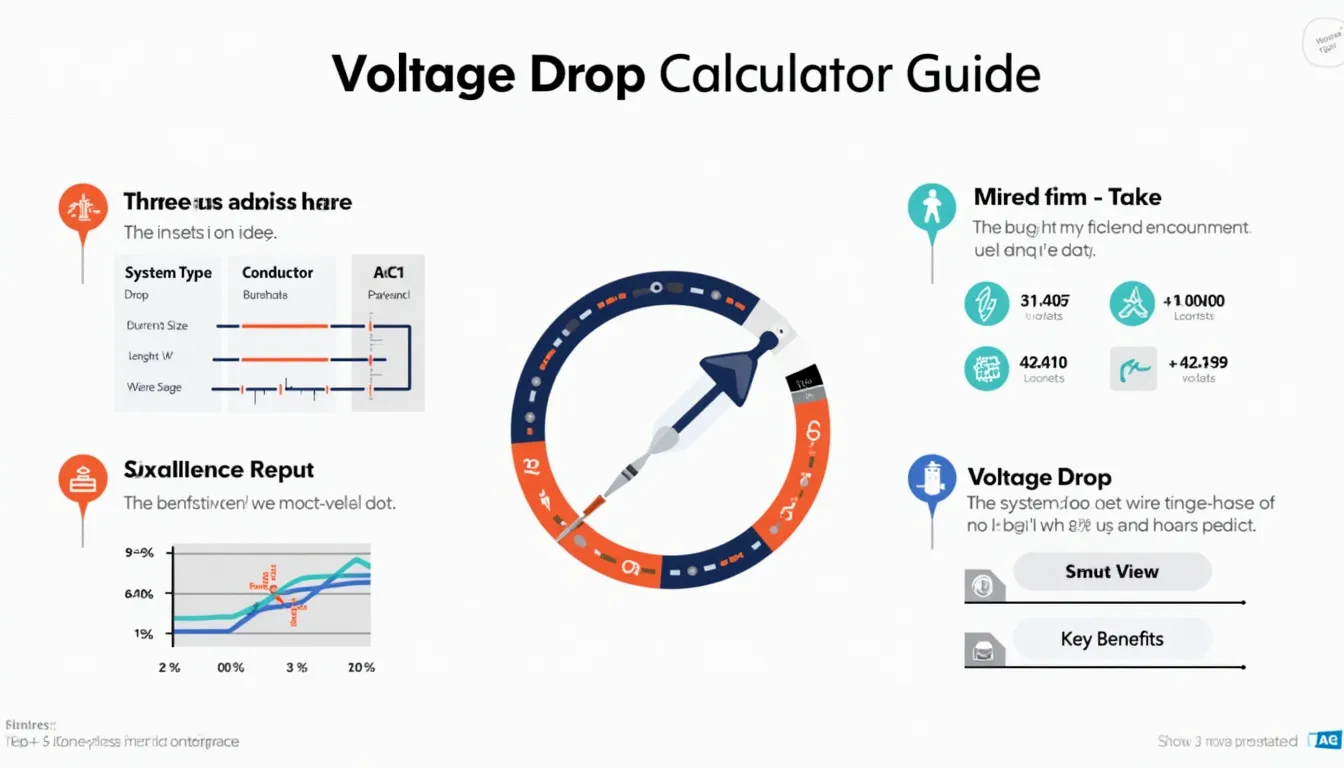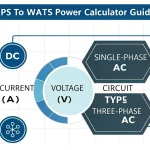Voltage Drop Calculator
Is this tool helpful?
How to use the tool
1 Select the system type
Pick DC, Single-phase AC, or Three-phase AC. Example inputs:
• 24 V DC solar string
• 400 V three-phase pump
2 Choose conductor material
Copper (lower resistance) or Aluminum (lighter, cheaper). Example: compare 10 m copper vs 150 m aluminum.
3 Set wire size (AWG)
Select from the list or match your design tables. Example sizes:
• AWG 10 for rooftop array
• AWG 8 for long industrial feeder
4 Enter conductor length
Total one-way run in metres; the tool internally uses the same value entered.
5 Enter load current
Amperes flowing through the conductor.
6 Supply voltage
Nominal line voltage.
7 Optional AC fields
Power factor (0-1) and Frequency (Hz).
Underlying formulas
- Resistive drop $$V_{DC}=I R$$
- Resistance $$R= rac{\rho L}{A}$$
- Inductive reactance $$X=2\pi f L_s L$$ (with (L_s)=0.5 µH m⁻¹)
- Single-phase AC $$V_{1\phi}=2I(R\cos\phi+X\sin\phi)$$
- Three-phase AC $$V_{3\phi}=\sqrt3 I(R\cos\phi+X\sin\phi)$$
- Percentage drop $$\%V= rac{V_{drop}}{V_{supply}}\times100$$
Worked examples
Example A 24 V DC array
- Material: copper ρ = 1.68 × 10⁻⁸ Ω·m
- AWG 10 A = 5.26 mm²
- L = 10 m I = 18 A
- R = 0.032 Ω Vdrop = 0.58 V
- %V = 2.4 % (compliant)
Example B 400 V 3-phase feeder
- Material: aluminum ρ = 2.82 × 10⁻⁸ Ω·m
- AWG 8 A = 8.36 mm²
- L = 150 m I = 60 A f = 50 Hz PF = 0.82
- R = 0.505 Ω X = 0.024 Ω
- Vdrop = 44.5 V %V = 11.1 % (non-compliant)
Quick-Facts
- NEC advises ≤3 % drop on branch circuits and ≤5 % overall (NEC 210.19, 2023).
- Copper resistivity 1.68 × 10⁻⁸ Ω·m @ 20 °C (ASM Handbook, 2017).
- Aluminum resistivity 2.82 × 10⁻⁸ Ω·m @ 20 °C (IEEE Std 141, 2010).
- IEC 60364 allows ≤5 % drop for most installations (IEC 60364-5-52, 2020).
- Copper averages US$8-10 kg; aluminum US$2-3 kg (LME Price Report, 2023).
FAQ
Why is voltage drop limited to 3-5 %?
Excess drop wastes energy and may starve loads; NEC 210.19 and IEC 60364 cap it at 3 % for lighting and 5 % otherwise (NEC 2023; IEC 2020).
How does wire size affect drop?
Larger cross-section lowers resistance rac{1}{A}; doubling area halves drop (ASM Handbook, 2017).
When should I upsize conductors?
If the tool shows >5 % loss, select the next AWG size or switch to copper to meet code limits (NEC 2023).
Does temperature change results?
Yes; resistance rises ~0.4 % / °C for copper above 20 °C (IEEE Std 1202, 2019). Adjust design for hot environments.
Is reactance important on short runs?
Below 30 m the X term contributes <1 % of total drop at 50/60 Hz, so resistance dominates (IEEE Red Book, 2010).
Can I use the calculator for 12 V automotive wiring?
Yes—select DC, input 12 V supply, and check that drop stays under 0.5 V for critical circuits (SAE J1292, 2018).
What about renewable systems?
PV arrays tolerate up to 3 % loss to maximise inverter efficiency (NREL Best Practices, 2022).
How does power factor influence AC drop?
Lower PF raises the reactive term: “Under inductive loads voltage drop increases in proportion to sin φ” (IEC 60364, 2020).
Important Disclaimer
The calculations, results, and content provided by our tools are not guaranteed to be accurate, complete, or reliable. Users are responsible for verifying and interpreting the results. Our content and tools may contain errors, biases, or inconsistencies. Do not enter personal data, sensitive information, or personally identifiable information in our web forms or tools. Such data entry violates our terms of service and may result in unauthorized disclosure to third parties. We reserve the right to save inputs and outputs from our tools for the purposes of error debugging, bias identification, and performance improvement. External companies providing AI models used in our tools may also save and process data in accordance with their own policies. By using our tools, you consent to this data collection and processing. We reserve the right to limit the usage of our tools based on current usability factors.







